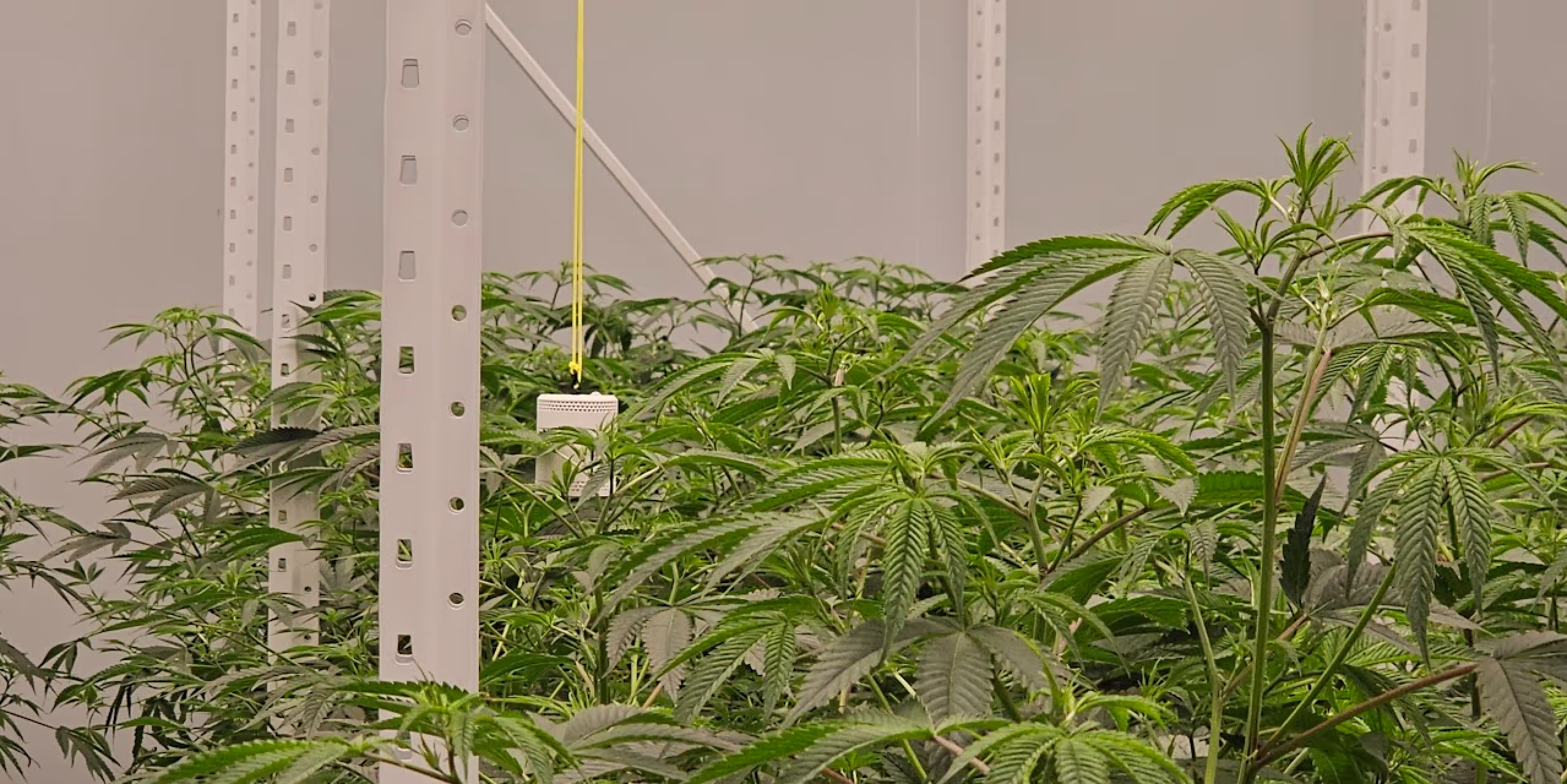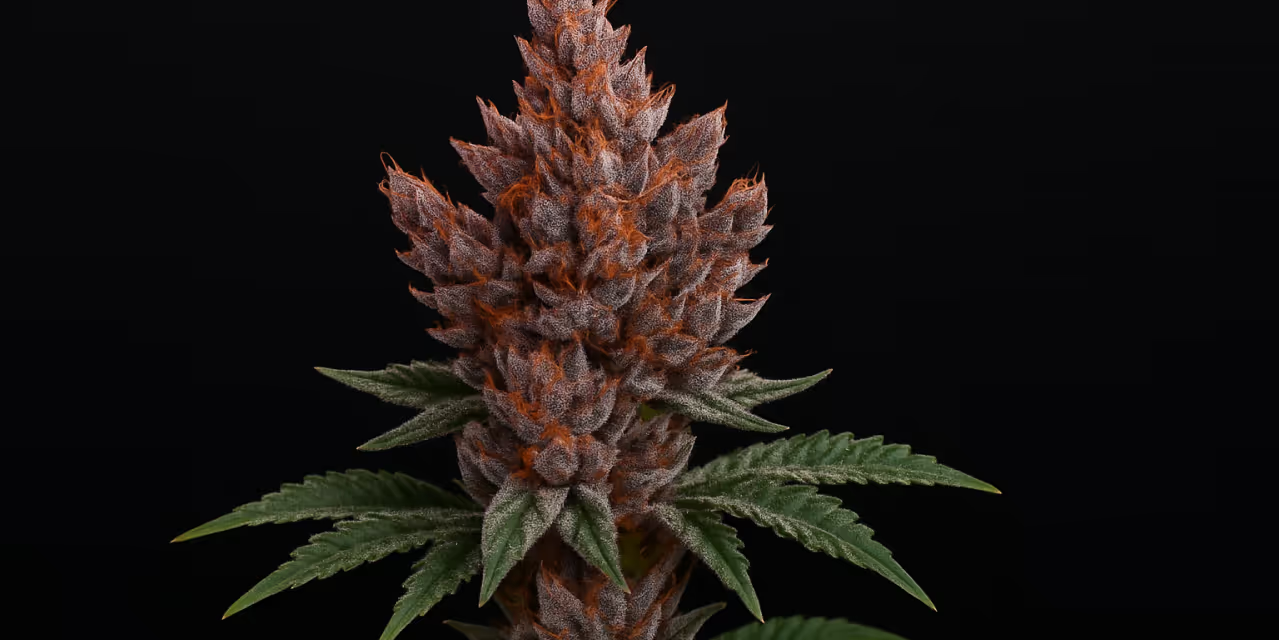Nitrogen deficiency in cannabis: Causes and solutions


Nitrogen deficiency is a common issue that many growers face
Fortunately, it's one of the easiest nutrient deficiencies to identify and correct.
Nitrogen is a critical nutrient that plays a vital role in plant growth, and without it, your cannabis plants can quickly start showing signs of distress, poor bud formation and lower yields.
In this post, we'll explore the symptoms of nitrogen deficiency, its causes, how to diagnose it, and most importantly, how to fix and prevent it.
Disclaimer: Any information given on this site is for educational purposes only. Please ensure if you’re growing cannabis, you’re doing so by the law and subject to appropriate permissions and licenses of the applicable country.
Why do plants need Nitrogen?
Nitrogen is one of the main nutrients plants need.
It’s vital because it is a core component of chlorophyll, the pigment responsible for photosynthesis, allowing plants to convert sunlight into energy.
Nitrogen is also essential for other plant processes, such as producing amino acids, which are small molecules or monomers.
These are the building blocks for larger protein polymers, essential for cell growth, structure, and repair.
In addition, nitrogen is a vital component of nucleic acids that make up DNA.
Without sufficient nitrogen, plants experience stunted growth, yellowing leaves, and reduced yields because of impaired metabolic processes.
Nitrogen helps to support vigorous vegetative growth, enhances leaf development, and ensures a healthy root system.
For cannabis cultivation, maintaining adequate nitrogen levels is crucial to achieving robust, healthy plants that can thrive and produce high-quality buds.
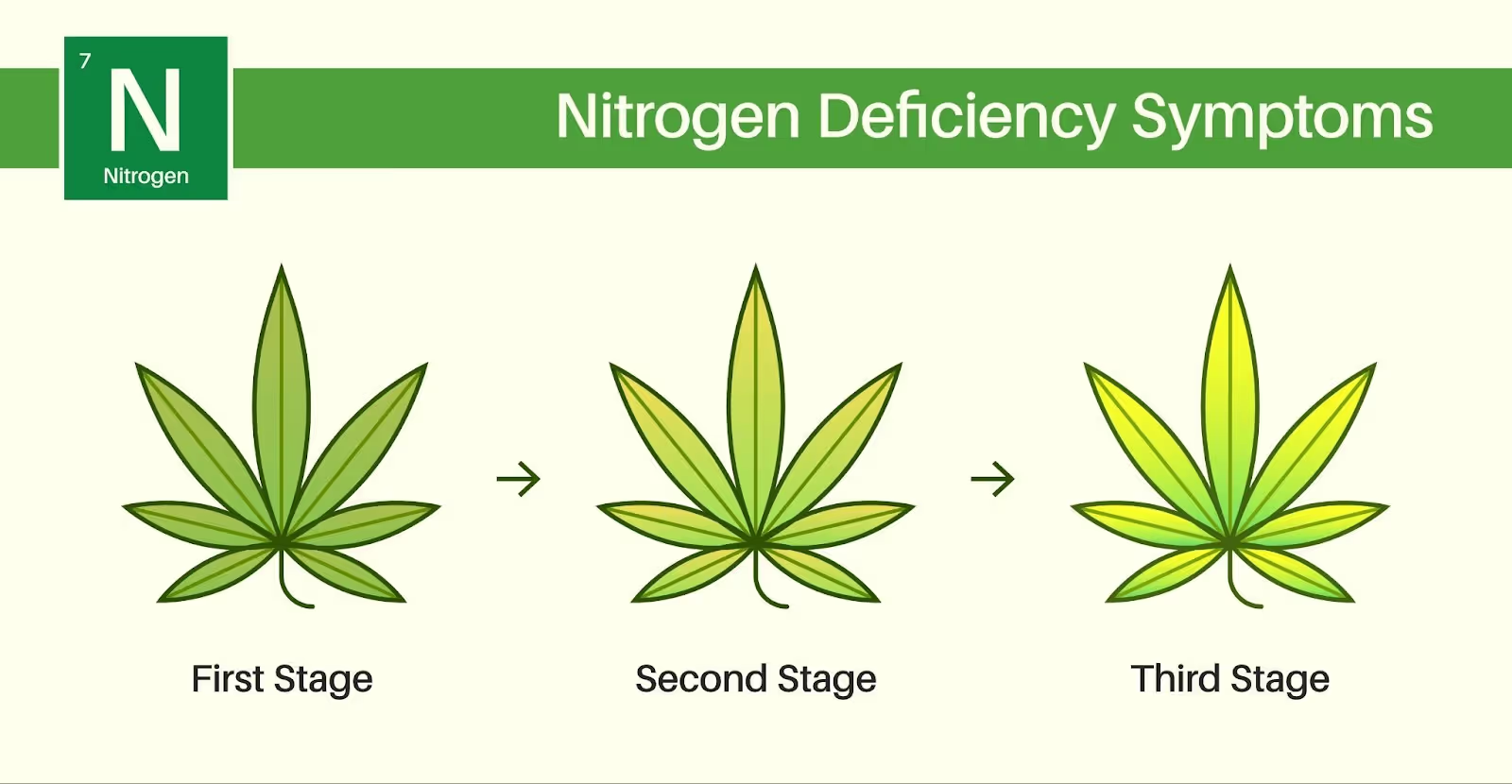
What nitrogen deficiency looks like
One of the first signs of nitrogen deficiency is a noticeable yellowing of the older leaves, typically towards the bottom of the plant, while the young leaves initially remain green.
Yellow leaves, known as chlorosis, occur when the plant begins to use up the nitrogen stored in the lower leaves when there is no more available in the growing medium.
As the deficiency progresses throughout the entire plant, these leaves start to turn completely yellow because of their low chlorophyll content, eventually dying and falling off if left unchecked.
A tell-tale sign of nitrogen deficiency is a gradual shift from a deep, dark green to a lighter green across the plant.
Unlike other nutrient deficiencies, which may show more complex patterns, nitrogen deficiency tends to be uniform and starts with older growth.
Causes of nitrogen deficiencies
Several factors can contribute to nitrogen deficiency:
Lack of nitrogen in the soil or growing medium
Sometimes, the medium itself may lack adequate nitrogen. This is particularly common in low-nutrient soils or reused media without proper supplementation.
Insufficient nutrition during the vegetative stage
Cannabis plants need the most nitrogen during the vegetative stage. The plants will quickly show signs of deficiency if the nutrition provided during this stage lacks enough nitrogen.
Inadequate pot size
Growing cannabis in pots that are too small for the plant's size can lead to deficiencies. As the roots fill the pot, they may exhaust the available nitrogen.
Outdoor planting conditions
Outdoor environments can sometimes be deficient in nitrogen, especially in areas with poor soil quality or heavy rains that leach nutrients away.
Poor drainage or overwatering
Excess water in the medium can wash away nitrogen, making it less available to the plant. Poor drainage or overwatering can also lead to waterlogged roots, reducing the plant's ability to absorb nutrients effectively.
This can create nutrient imbalances, including nitrogen deficiency, even when adequate nitrogen is present in the soil.
Underfeeding and low nitrogen concentration
Some growers may inadvertently underfeed their plants or use nutrients with a low nitrogen concentration.
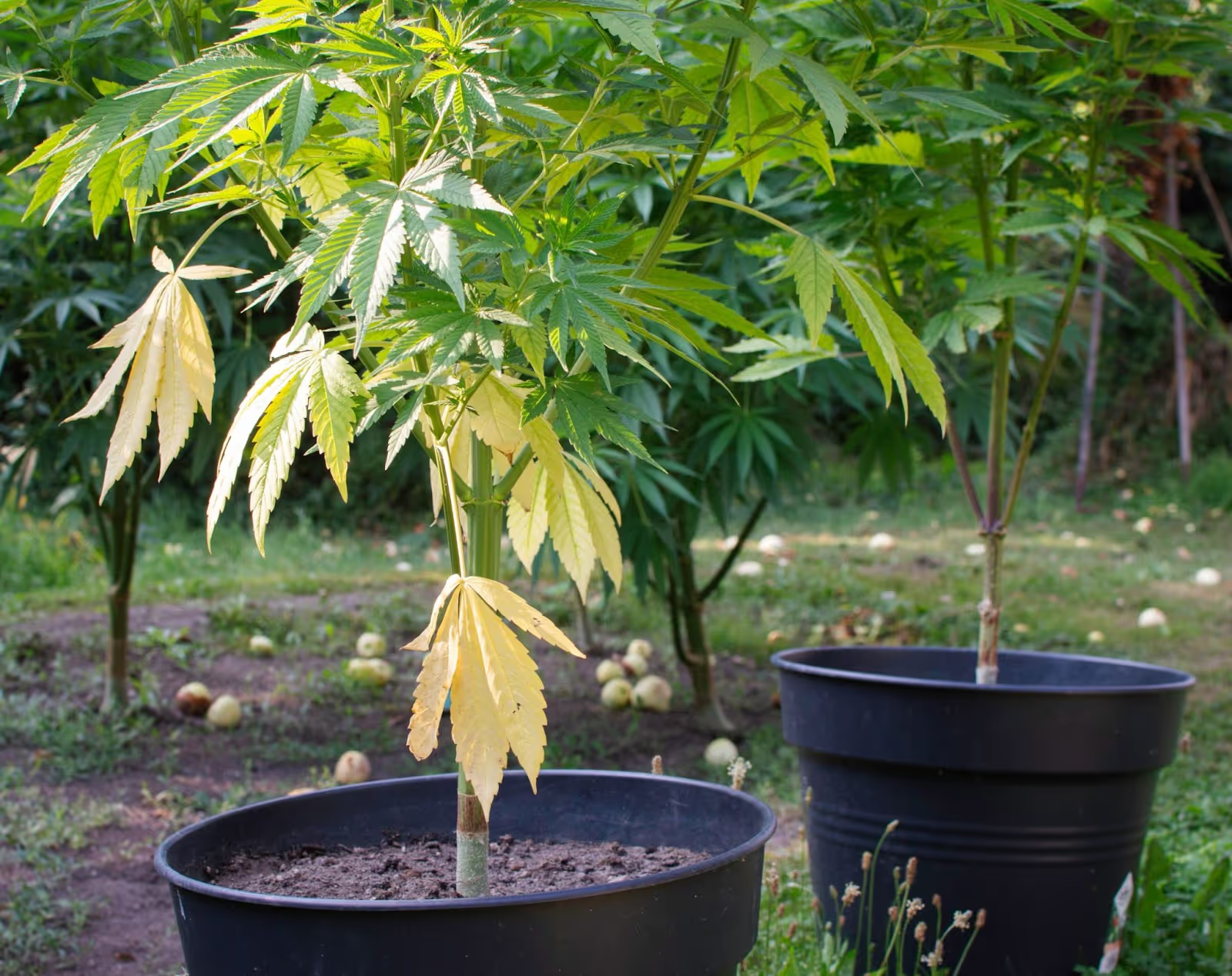
Diagnosing nitrogen deficiency in cannabis plants
Diagnosing nitrogen deficiency involves a few straightforward steps:
Visual inspection
Begin by examining the leaves for signs of yellowing, particularly at the lower, older parts of the plant. Look for a uniform pale green appearance that progresses to yellow.
Measuring pH levels
Check the pH level of your soil or medium. An improper pH can affect nitrogen uptake, making it seem like there’s a deficiency when it's actually a pH imbalance.
You can tell if you're underfeeding your plants by measuring the runoff. Feed or water your plants and collect 10% to 15% of the runoff from the bottom of the pot.
Use a pH meter to measure pH. If the pH is higher than the ideal pH for the medium, you need to feed more.
If the pH is lower than the ideal for your medium, you're probably underfeeding the plant.
Checking overall plant health
Assess the overall health and growth of your plants. Stunted growth and a pale green appearance across the plant indicate a lack of nitrogen.
Stay ahead in gardening – join the Grow The Best newsletter!

How to fix nitrogen deficiency in cannabis
Once nitrogen deficiency has been identified, it’s time to take corrective action:
Use a nitrogen rich organic fertiliser
Adding a nitrogen rich liquid plant food can quickly address the signs of a deficiency.
Look for products specifically formulated for the vegetative stage, which usually contain higher nitrogen levels.
Incorporate organic supplements
Organic options like blood meal, fish emulsion, or composted manure can help boost nitrogen levels and treat nitrogen deficiency.
These supplements release nitrogen slowly, providing a steady supply to your plants.
Adjust feeding schedules
Regular feeding with balanced nutrients that include sufficient nitrogen is essential.
Ensure your schedule for feeding is consistent with the plant’s growth stage, particularly during the vegetative phase.
Monitor plant response
After adjusting the nutrient levels, monitor how your plants respond. Look for signs of recovery, such as new green growth and halting of yellowing leaves.

Preventing nitrogen deficiency
Prevention is always better than cure. To prevent nitrogen deficiency:
Regular feeding with balanced plant food
Ensure that your plants receive a steady supply of balanced plant nutrients, including enough nitrogen, particularly during veg.
This will ensure that your plants’ leaves remain green.
Correct pot size and proper soil conditions
Use appropriately sized pots and ensure the soil is rich in organic matter and nutrients. Test the soil regularly to maintain optimal conditions.
Monitor pH levels and soil health
Check pH levels regularly to prevent nutrient lockout. Measuring runoff can help you adjust feeding and ensure your plant roots can absorb nitrogen and the other nutrients they need.
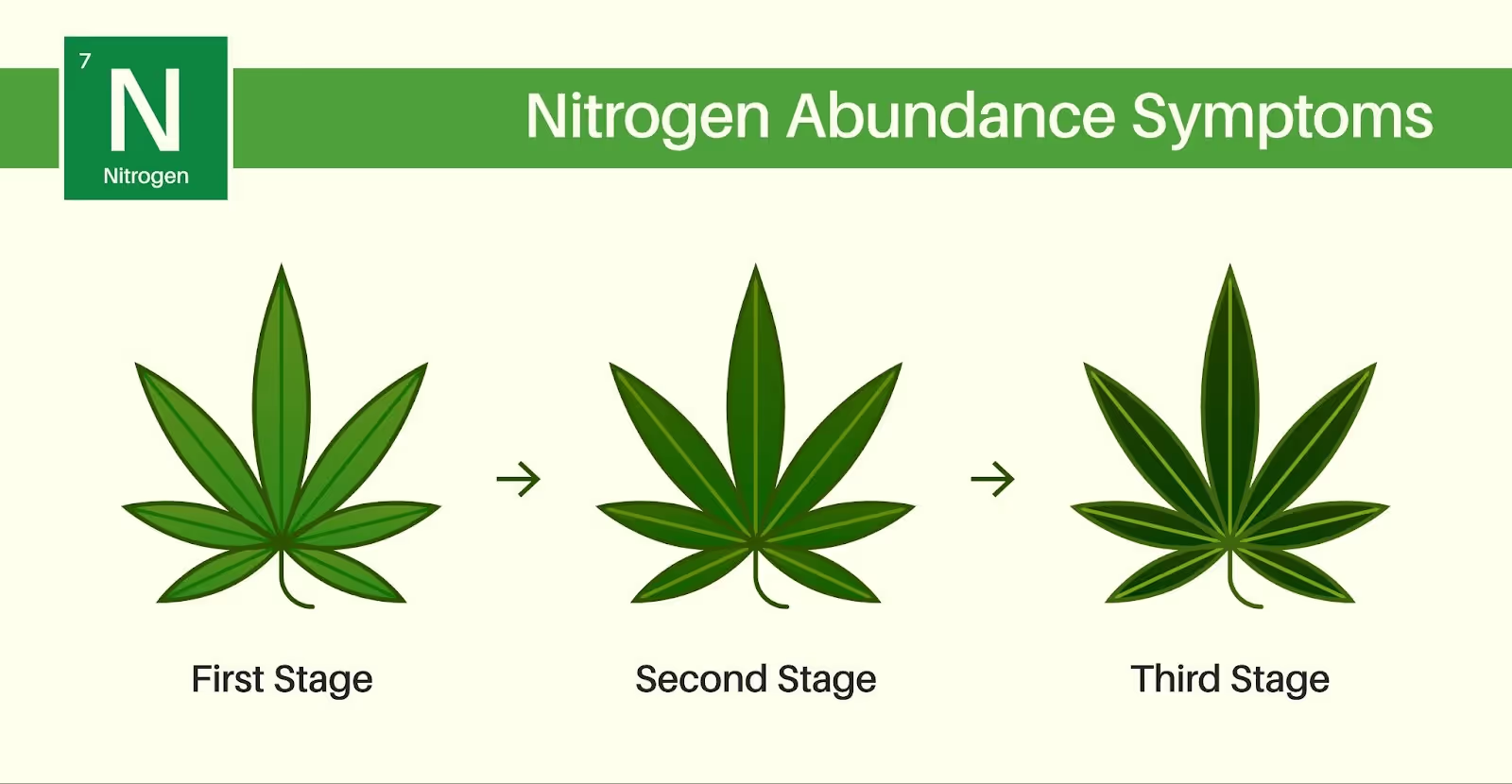
Nitrogen toxicity
While it's crucial to address nitrogen deficiency, it's equally important to avoid excessive nitrogen, especially during the flowering stage.
Over fertilisation with nitrogen can lead to toxicity.
This manifests as especially dark green leaves, sometimes with clawed or curled tips, and can severely impact plant growth and lead to a bad smelling or tasting final product.
Excessive nitrogen can also reduce yields, making it essential to strike the right balance for optimal plant health.
Takeaways
Addressing nitrogen deficiency involves recognising the symptoms, diagnosing the issue correctly, and taking prompt action to restore the right balance of nutrients.
Regular monitoring, balanced nutrition, and understanding the needs of your plants at each growth stage are key to ensuring adequate levels of important nutrients, preventing any deficiencies and promoting healthy growth.
Keep an eye on your cannabis plants, and they’ll reward you with a bountiful, vibrant yield.
Happy growing!
FAQs
How do you recover from nitrogen deficiency?
Recovering from nitrogen deficiency involves a few key steps to restore the plant's health and ensure optimal growth. Here’s how to address this issue effectively:
- Apply nitrogen rich fertiliser: Start by using pre mixed nutrients to replenish the nitrogen levels in the soil. Look for fertilisers specifically designed to provide more nitrogen, which will help correct the deficiency and promote healthy leaf growth.
- Add organic supplements: Incorporate organic nitrogen rich supplements like blood or fish meal, or organic matter. These can provide a natural boost of nitrogen and improve overall soil fertility.
- Adjust feeding program: Ensure that your feeding program includes a balanced nutrient mix that covers all essential nutrients, including nitrogen. Regular, adequate feeding is particularly important during the vegetative stage.
- Monitor pH levels: Check the pH level of your soil regularly. If the pH is too high or too low, uptake can be affected. Adjust the pH to fall within the ideal range for your medium.
- Test soil and runoff: Perform regular soil testing and check the runoff to ensure your plants get the right nutrient balance. Adjust your feeding practices based on these tests to prevent further deficiencies.
With these steps, you can fix nitrogen deficiency in plants, restore their health, and support robust plant growth and yield.
What is one of the earliest symptoms of a nitrogen deficiency?
One of the earliest symptoms of a nitrogen deficiency in marijuana plants is the yellowing of the older leaves, usually those at the bottom of the plant.
These early signs typically start with the leaves losing their green pigment and turning to a lighter shade.
As the deficiency progresses, these leaves become progressively more yellow and may eventually die off.
Yellow leaves happen because the plant is drawing on the nitrogen reserves stored in the older leaves to support its growth.
In addition to leaves that turn yellow, you might notice stunted growth and reduced plant health, as nitrogen is crucial for vegetative growth and overall plant development.
Early detection of nitrogen deficiency is essential for addressing the issue promptly.
Corrective measures include applying a nitrogen rich fertiliser, adjusting your feeding program, and ensuring proper soil pH.
By taking these steps, you can help your cannabis plants recover from nitrogen deficiencies quickly and maintain healthy plant growth.
Will nitrogen deficient leaves turn green again?
Once marijuana leaves have turned yellow because of nitrogen deficiency, they typically do not turn green again.
The yellowing occurs because the plant is using up the nitrogen stored in the leaves to support its growth, leading to a loss of chlorophyll and resulting in the yellow appearance.
However, while the affected leaves of a cannabis plant won’t recover their green colour, the marijuana plant can still bounce back if the marijuana nitrogen deficiency is addressed promptly.
Apply a nitrogen rich fertiliser or organic nitrogen rich supplements like blood meal or fish meal to support recovery and promote healthy new growth.
Ensure you also adjust your feeding program to provide a balanced mix of nutrients and maintain proper soil pH.
The growth that emerges after addressing the deficiency will be green and healthy, reflecting the restored nitrogen levels in the soil.
Regular soil testing and monitoring of the pH level will help ensure that the plant receives the right nutrients for optimal recovery and growth.
Can cannabis recover from nitrogen toxicity?
Yes, Marijuana plants can recover from nitrogen toxicity, but it requires prompt and careful management.
Nitrogen toxicity occurs when there’s an excess of nitrogen in the soil, leading to symptoms like dark green, curled leaves, and reduced yield.
Fortunately, with the right approach, your marijuana plant can bounce back and return to optimal health.
Recovery begins by reducing the use of nitrogen rich fertiliser and switching to a balanced nutrient mix that provides all important nutrients without excessive nitrogen.
Flushing the soil with plenty of water can help remove excess nitrogen and other nutrients, aiding recovery.
Ensure you adjust your feeding schedule to avoid over-fertilisation and monitor the pH level of your soil, as imbalances can hinder recovery.
Regular soil testing is crucial to track nutrient levels and pH, ensuring they remain within the ideal range.
Also, proper recovery care, including appropriate watering and maintaining a balanced feeding regime, supports the plant’s overall health and growth.
How long does it take for nitrogen toxicity to heal?
Nitrogen toxicity in cannabis plants occurs when they receive too much nitrogen, leading to issues such as dark green, curled marijuana leaves and reduced yield.
Healing from excessive nitrogen involves several steps and may take some time.
Typically, it takes 1 to 2 weeks for marijuana plants to recover from too much nitrogen once corrective measures are taken. The healing time depends on the severity of the toxicity and the plant’s overall health.
Enhance your gardening skills – subscribe to the Grow The Best newsletter today!









.avif)


